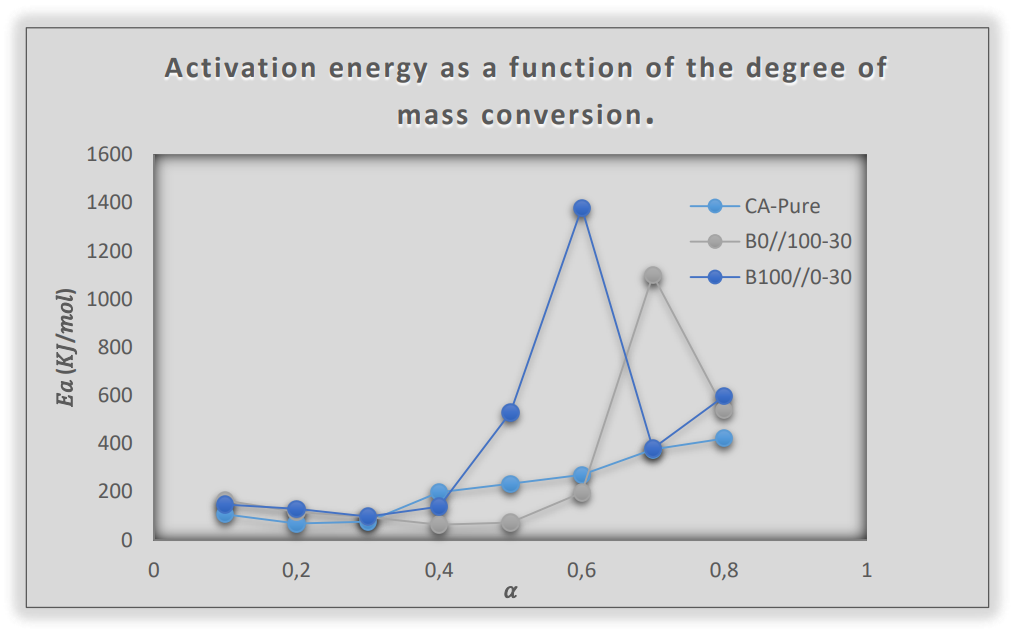Synthesis of Hybrid Cellulose Acetate Membranes and Application of the Flynn-Wall-Ozawa Isoconversional Method
DOI:
https://doi.org/10.14295/vetor.v33i1.15165Keywords:
Hybrids Membranes, Sol-gel Synthesis, Degradation Kinetics, Isoconversional Method, Flynn-Wall-Ozawa (FWO) MethodAbstract
The synthesis of hybrid materials is a promising alternative in the production of materials with optimized properties. In this context, the classic cellulose acetate membranes are being modified. It is worth mentioning that knowing the thermal stability of cellulosic materials is an essential factor in their use since organic polymers have low thermal resistance, limiting their applicability. This work evaluates the synthesis and the study of the thermal degradation kinetics of hybrid cellulose acetate membranes. The synthesis was carried out using the sol-gel process, with the phase inversion technique, through the reaction of cellulose acetate with organometallic precursors: tetraethyl orthosilicate, TEOS; 3-aminopropyl triethoxysilane, APTES, and titanium isopropoxide, TiPOT, in fixed composition. Thermal characterization was performed with thermogravimetric analysis at different heating rates under a nitrogen atmosphere. The kinetic parameter of thermal decomposition activation energy, Ea, was estimated with the isoconversional method proposed by Flynn-Wall-Ozawa (FWO). The degradation kinetics shows that the change in the chemical composition of the samples directly interferes with their thermal properties. Thus, it is possible to observe that the activation energy found for the reference sample, AC-Pure, in the first and second batches was 233.5 and 219.05 kJ/mol, respectively. The composition modification results in an increase in activation energy, in which sample B0//100-30 recorded 310.31 and 226.05 kJ/mol in the first and second batches; and sample B100//0-30 reached 452.73 and 424.74 kJ/mol. It is clear that the increase in the thermal resistance of the samples is associated with the change in the chemical composition and must be attributed to the increase in the TEOS content in the composition due to the formation and increase in the presence of siloxane groups in the material.
Downloads
References
A. M. Pandele, F. E. Comanici, C. A. Carp, F. Miculescu, S. I. Voicu, V. K. Thakur, and B. C. Serban, “Synthesis and characterization of cellulose acetate-hydroxyapatite micro and nanocomposites membranes for water purification and biomedical applications,” Vacuum, vol. 146, pp. 599-605, 2017. Available at: https://doi.org/10.1016/j.vacuum.2017.05.008
H.R. Zuo, P. Shi, and M. Duan, “A review on thermally stable membranes for water treatment: Material, fabrication, and application,” Separation and Purification Technology, vol. 236, paper no. 116223, 2020. Available at: https://doi.org/10.1016/j.seppur.2019.116223
M. C. Andrade, J. C. Pereira, N. Almeida, P. Marques, M. Faria, and M. C. Gonçalves, “Improving hydraulic permeability, mechanical properties, and chemical functionality of cellulose acetate-based membranes by co-polymerization with tetrathyl orthosilicate and 3-(aminopropyl) triethoxysilane,” Carbohydrate Polymers, vol. 261, paper no. 117813, 2021. Available at: https://doi.org/10.1016/j.carbpol.2021.117813
M. Rigoletto, P. Calza, E. Gaggero, and E. Laurent, “Hybrid materials for the removal of emerging pollutants in water: classification, synthesis, and Properties,” Chemical Engineering Journal Advances, vol. 10, paper no. 100252, 2022. Available at: https://doi.org/10.1016/j.ceja.2022.100252
G. M. Ferreira, “Production and characterization of hybrid cellulose acetate membranes,” Master's Dissertation, Graduate Program in Materials Science and Technology, Polytechnic Institute, Rio de Janeiro State University, Nova Friburgo, Brazil, 2022, in Portuguese. Available at: http://www.bdtd.uerj.br/handle/1/17895
N. R. S. Araujo, “Studying the kinetics of complex materials: reaction and activation energy distribution models using Hopfield neural networks,” Master’s Dissertation, Chemistry Department, Institute of Exact Sciences, Federal University of Minas Gerais, Belo Horizonte, Brazil, 2021, in Portuguese. Available at: https://repositorio.ufmg.br/handle/1843/37145
V. M. K. Rocha, “Study of the kinetics of degradation of polyester resin from renewable source. Master's Dissertation, Graduate Program in Mining, Metallurgical and Materials Engineering, University of Rio Grande do Sul, Porto Alegre, Brazil, 2018, in Portuguese. Available at: https://lume.ufrgs.br/handle/10183/195760
A. K. Burnham, X. Zhou, and L. J. Broadbelt, “Critical review of the global chemical kinetics of cellulose thermal decomposition. Energy and Fuels,” Energy Fuels, vol. 29, pp. 2906−2918, 2015. Available at: https://pubs.acs.org/doi/10.1021/acs.energyfuels.5b00350
D. B. Dwyer, N. C. Gallego, J. L. Niedziela, R. J. Kapsimalis, and D. C. Duckworth, “Product specific thermal degradation kinetics of bisphenol F epoxy in inert and oxidative atmospheres using evolved gas analysis–mass spectrometry,” Journal of Analytical and Applied Pyrolysis, vol. 165, pp. 3794-3801, 2022. Available at: https://doi.org/10.1016/j.jaap.2022.105563
G. Mendes, M. Faria, A. Carvalho, M. C. Gonçalves, and M. N. Pinho, “Structure of water in hybrid cellulose acetate-silica ultrafiltration membranes and permeation properties,” Carbohydrate Polymers, vol. 189, pp. 342-531, 2018. Available at: https://doi.org/10.1016/j.carbpol.2018.02.030
E. A. M. Ribeiro, “Synthesis, Characterization and Application of Cellulose Acetate Membranes from Recycled Corn Straw in Ultrafiltration Process,” Master's Dissertation, Graduate Program in Chemistry, Federal University of Uberlândia, Minas Gerais, Brazil, 2013, in Portuguese. Available at: https://repositorio.ufu.br/handle/123456789/17389
I. Peixoto, M. Faria, and M. C. Gonçalves, “Synthesis and Characterization of Novel Integral Asymmetric Monophasic Cellulose–Acetate/Silica/Titania and Cellulose–Acetate/Titania Membranes,” Membranes, vol. 10, pp. 2-26, 2020. Available at: https://doi.org/10.3390/membranes10090195
R. P. Pandey, P. Kallem, P. A. Rasheed, K. A. Mahmoud, F. Banat, W. J. Lau, and S. W. Hasan, “Enhanced water flux and bacterial resistance in cellulose acetate membranes with quaternary ammoniumpropylated polysilsesquioxane,” Chemosphere, vol 289, paper no. 133144, 2022. Available at: https://doi.org/10.1016/j.chemosphere.2021.133144
D. Souza, “Study of the thermal stability of cellulose acetate propionate modified with short-chain polyhydroxyalkanoate,” Master's Dissertation, Graduate Program in Materials Science and Engineering, State University of the North Fluminense, Campos do Goytacazes, Rio de Janeiro, Brazil, 2006. Available at: https://uenf.br/posgraduacao/engenharia-de-materiais/wp-content/uploads/sites/2/2013/07/Dissertação-de-Mestrado-Djalma.pdf
I. C. de Miranda, “Study of the Kinetic Parameters of Thermal Decomposition of Lignocellulosic Residues and Characterization by TA, FTIR and EDXRF,” Doctoral Thesis, Postgraduate Program in Chemical and Biochemical Process Technology, Federal University of Rio de Janeiro, Rio de Janeiro, Brazil, 2013, in Portuguese. Available at: http://epqb.eq.ufrj.br/wp-content/uploads/2021/10/d13_17.pdf
G. M. Ferreira, D. da S. Herdi, K. C. da Silveira, M. C. Gonçalves, and M. C. Andrade, “Evaluation of Thermal Degradation Kinetics of Hybrid Cellulose Acetate Membranes using Isoconversional Methods,” Vetor - Revista de Ciências Exatas e Engenharias, vol. 32, no. 1, pp. 52–61, 2022. Available at: https://doi.org/10.14295/vetor.v32i1.13766
M.D.M. Brites, “Development of nanofiber membranes based on cellulose acetate from sugarcane bagasse produced by electrowinning for the incorporation of enzymes,” Master's Dissertation, Graduate Program in Textile and Fashion, School of Arts, Sciences and Humanities, University of São Paulo, Brazil, 2015. Available at: https://www.teses.usp.br/teses/disponiveis/100/100133/tde-07122015-233822/publico/mariana_brites.pdf
M. M. Mariano, “Structural Evaluation of TiO2 Obtained by Traditional Sol-Gel and Hydrothermal Routes,” Course Completion Paper, Federal Center for Technological Education of Minas Gerais, Belo Horizonte, Brazil, 2019, in Portuguese. Available at: https://www.eng-materiais.bh.cefetmg.br/wp-content/uploads/sites/189/2019/09/TCC-II_Versão-Final_MAIRA-M-MARIANO.pdf
G. P. Alves, “A poly(dimethylsiloxane) network functionalized with the amino group on activated carbon particles for metal ion adsorption,” Master's Dissertation, Graduate Program in Chemistry, Federal University of Alfenas, Minas Gerais, Brazil, 2021, in Portuguese. Available at: https://bdtd.unifal-mg.edu.br:8443/handle/tede/1300
E. C. A. Rosa, R. F. B. Gonçalves, M. G. Domingues, L. E. N. Almeida, A. C. Silva, and J. A. F. F. Rocco, “Determination of kinetic parameters and computer simulation of perfluoropolyether (PFPE) used as a synthetic lubricant,” Química Nova, vol. 42, no. 7, pp. 760-767, 2019. Available at: https://s3.sa-east-1.amazonaws.com/static.sites.sbq.org.br/quimicanova.sbq.org.br/pdf/v42n7a07.pdf
M. Faria, C. Moreira, T. Eusébio, P. Brogueira, and M. N. Pinho, “Hybrid flat sheet cellulose acetate/silicon dioxide ultrafiltration membranes for uremic blood purification,” Cellulose, vol. 27, pp. 3847-3869, 2020. Available at: https://link.springer.com/article/10.1007/s10570-020-02985-2
















